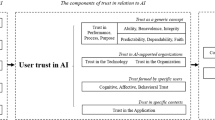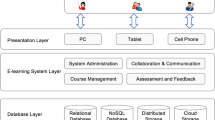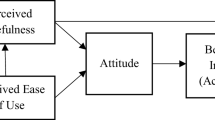Abstract
User interface (UI) and user experience (UX) is the first thing users come to interact when accessing internet services. However, UI/UX, which did not put users into consideration when designed, causes many inconveniences. In order to provide a customized UI/UX, the accurate analysis of users are important and must be optimized for users through continuous updates. In this paper, we propose a method of analyzing the user’s cognitive and behavioral information in a distributed environment, providing a customized UI/UX based on the analysis. The proposed method measures the user’s cognitive ability and generates an initial profile, then provides a custom UI/UX by modifying the profile based on the user’s behavioral information. To generate the user profile, the cognitive response measurement and modeling of 122 users were performed and the proposed model was evaluated by 200 users. As a result of the experiment, overall satisfying results were obtained.









Similar content being viewed by others
References
Dery-Pinna, A.M., Fierstone, J., Picard, E.: Component model and programming: a first step to manage human–computer interaction adaptation. Int. Conf. Mob. Hum. Comput. Interact. 2795, 456–460 (2003)
Park, R.C., Jung, H., Shin, D.K., Kim, G.J., Yoon, K.H.: M2M-based smart health service for human UI/UX using motion recognition. Clust. Comput. 18(1), 221–232 (2015)
Park, J., Han, S.H., Kim, H.K., Cho, Y., Park, W.: Developing elements of user experience for mobile phones and services: survey, interview, and observation approaches. Hum. Factors Ergon. Manuf. Serv. Ind. 23(4), 279–293 (2013)
Voutilainen, J.P., Salonen, J., Mikkonen, T.: On the design of a responsive user interface for a multi-device web service. In: Proceedings of the Second ACM International Conference on Mobile Software Engineering and Systems, pp. 60–63 (2015)
Moon, J., Lim, T.B., Kim, K.W., Lee, S.P., Lee, S.: Advanced responsive web framework based on MPEG-21. In: Proceedings of the IEEE International Conference, pp. 197–199. Consumer Electronics, Berlin (2012)
Rajpal, K.S., Kaur, M.: Automated UI & UX framework. Int. J. Adv. Res. Ideas Innov. Technol. 3, 16–22 (2017)
Park, H.S., Kim, H.W., Park, C.J.: Dynamic-interaction UI/UX design for the AREIS. Proc. Int. Conf. Hum. Comput. Intera. 9732, 412–418 (2016)
Kim, Y., Kwak, M., Kim, E.: The development of the user-customizable favorites-based smart phone UX/UI using tap pattern similarity. J. Korea. Soc. Comput. 19(8), 95–106 (2014)
Chen, X.A., Grossman, T., Wigdor, D.J. Fitzmaurice, G.: Duet: exploring joint interactions on a smart phone and a smart watch. In: Proceedings of the SIGCHI Conference on Human Factors in Computing Systems, pp. 159–168. (2014)
Hooshyar, D., Ahmad, R.B., Yousefi, M., Fathi, M., Horng, S.J., Lim, H.: Applying an online game-based formative assessment in a flowchart-based intelligent tutoring system for improving problem-solving skills. Comput. Educ. 94, 18–36 (2016)
Hooshyar, D., Ahmad, R.B., Yousefi, M., Fathi, M., Horng, S.J., Lim, H.: SITS: a solution-based intelligent tutoring system for students’ acquisition of problem-solving skills in computer programming. Innov. Educ. Teach. Int. (2016). doi:10.1080/14703297.2016.1189346
Hooshyar, D., Yousefi, M., Lim, H.: A Procedural Content Generation-Based Framework for Educational Games: Toward a Tailored Data-Driven Game for Developing Early English Reading Skills. J. Educ. Compu. Res. (2017). doi:10.1177/0735633117706909
Timmann, D., Drepper, J., Frings, M., Maschke, M., Richter, S., Gerwig, M.E.E.A., Kolb, F.P.: The human cerebellum contributes to motor, emotional and cognitive associative learning. A review. Cortex 46(7), 845–857 (2010)
Keele, Steven W.: Movement control in skilled motor performance. Psychol. Bull. 70(6), 387 (1968)
Caplan, B.: Edinburgh handedness inventory. Encyclopedia of clinical neuropsychology. Springer, New York (2011)
Harrington, M., Sawyer, M.: L2 working memory capacity and L2 reading skill. Stud. Secon. Lang. Acquis. 14(1), 25–38 (1992)
Dannenbring, G.L., Briand, K.: Semantic priming and the word repetition effect in a lexical decision task. Can. J. Psychol. 36(3), 435 (1982)
Newman, S.D., Carpenter, P.A., Varma, S., Just, M.: Frontal and parietal participation in problem solving in the Tower of London: fMRI and computational modeling of planning and high-level perception. Neuropsychologia 41(12), 1668–1682 (2003)
Kimura, D.: Spatial localization in left and right visual fields. Can. J. Psychol. 23(6), 445 (1969)
Lee, B.J., Kwon, J.S., Go, G.C., Choi, Y.L.: A method for analyzing web log of the hadoop system for analyzing a effective pattern of web ysers. J. Korea Soc. IT serv. 13(4), 231–243 (2014)
Choi, S.I., Kim, N.G.: Identifying the interests of web category visitors using topic analysis. J. Inf. Technol. Appl. Manage. 21(4), 415–429 (2014)
Lee, H.J.: An analysis on communication behaviors performed by digital photography community users–focusing on the photo gallery service, NAVER. Yonsei University Graduate School of Journalism and Broadcasting Master’s Thesis (2011)
Lee, D.C., Lee, E.J., Kim, B.S., Jin, G.O.: Study of influencing factors in internet shopping of the consumer’s purchase intention. Manage. Inf. Syst. Rev. 30(1), 211–226 (2011)
Jang, S.H.: Web site analysis using data mining: around web log analysis. Korea University Graduate School of Computer and Information System Master’s Thesis (2010)
Park, K., Lim, H.: Acquiring lexical knowledge using raw corpora and unsupervised clustering method. Clust. comput. 17(3), 901–910 (2014)
Piga, L., Bergamaschi, R.A., Rigo, S.: Empirical and analytical approaches for web server power modeling. Clust. Comput. 17(4), 1279–1293 (2014)
Lee, S., Hooshyar, D., Ji, H., Nam, K., Lim, H.: Mining biometric data to predict programmer expertise and task difficulty. Clust. Comput. 22, 1–11 (2017)
Islam, M.J., Wu, Q.J., Ahmadi, M., Sid-Ahmed, M.A.: Investigating the performance of naive-bayes classifiers and k-nearest neighbor classifiers. J. Conv. Inf. Technol. 5(2), 133–137 (2007)
Pal, M., Mather, P.M.: An assessment of the effectiveness of decision tree methods for land cover classification. Remot. Sens. Env. 86(4), 554–565 (2003)
Mazurowski, M.A., Habas, P.A., Zurada, J.M., Lo, J.Y., Baker, J.A., Tourassi, G.D.: Training neural network classifiers for medical decision making: The effects of imbalanced datasets on classification performance. Neural Netw. 21(2), 427–436 (2008)
Saxena, A., Saad, A.: Evolving an artificial neural network classifier for condition monitoring of rotating mechanical systems. Appl. Soft Comput. 7(1), 441–454 (2007)
Mavroforakis, M.E., Theodoridis, S.: A geometric approach to support vector machine (SVM) classification. IEEE Transact. Neural Netw. 17(3), 671–682 (2006)
Moreno, P.J., Ho, P.P., Vasconcelos, N.: A Kullback-Leibler divergence based kernel for SVM classification in multimedia applications. Advances in neural information processing systems. MIT Press, Cmabridge (2003)
Yousefi, M.: An agent-based simulation combined with group decision-making technique for improving the performance of an emergency department. Braz. J. Med. Biol. 50(5), e5955 (2017)
Acknowledgements
This research was supported by Basic Science Research Program through the National Research Foundation of Korea (NRF) funded by the Ministry of Science, ICT and future Planning (NRF-2016R1A2B2015912).
Author information
Authors and Affiliations
Corresponding author
Rights and permissions
About this article
Cite this article
Ji, H., Yun, Y., Lee, S. et al. An adaptable UI/UX considering user’s cognitive and behavior information in distributed environment. Cluster Comput 21, 1045–1058 (2018). https://doi.org/10.1007/s10586-017-0999-9
Received:
Revised:
Accepted:
Published:
Issue Date:
DOI: https://doi.org/10.1007/s10586-017-0999-9




